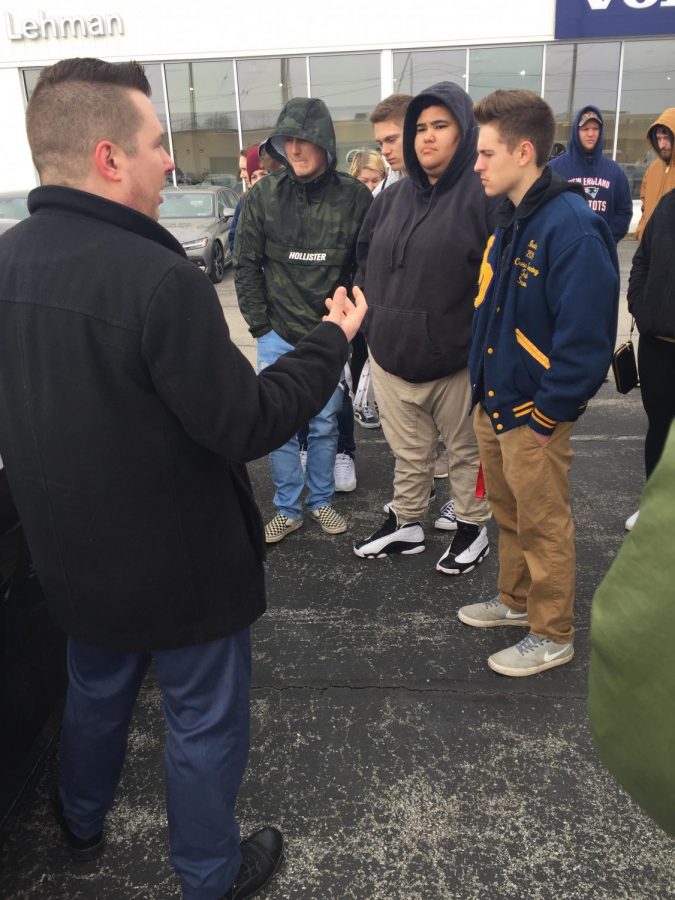Consumer Math Field Trip to Real World Experiences
March 14, 2019
On March 7, a great majority of the senior class took part in a consumer math field trip to a local car dealership and apartment complex in order to further their understanding of real-world math.
Department head Rick Meinl and consumer math teacher Eric Updegrove came up with the idea for the field trip as a way to continue to make consumer math realistic for students.
As such, Updegrove explained: “Recently, a lot of former students have reached out and discussed with me about how lucky they were to of taken the class and metnioned that the two biggest things, thus far, that they have dealt with were buying a new vehicle and renting. I felt that these were the most likely real world experiences that they would have to encounter on their own and wanted to make sure that they got to hear from people in that world and not just take my word for it.”
Approximately 75 seniors took part in the field trip; math teachers James McDonald and Updegrove divided the students into two groups for the day’s trip to make the time at each location more meaningful.
Half of the students began their trip at Lehman Volvo Cars of York. Here, consultant Wayne Staib walked the lot with students explaining how the labels on each car worked.
He pointed out that the labels provide the necessary information to understand the make and model of the vehicle, fuel efficiency, price, and warranty.
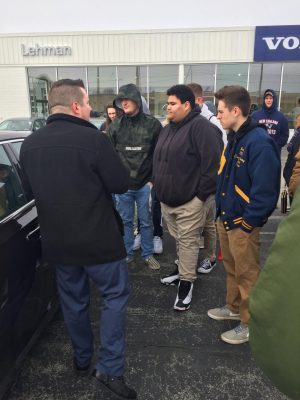
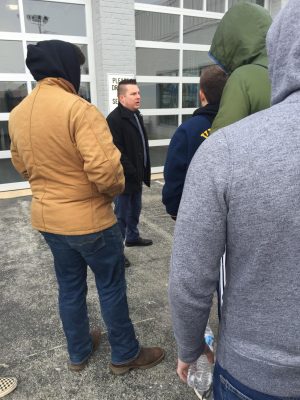
After walking the lot, Staib took students to a small conference room where he presented them with a slideshow, water bottles, and bags of potato chips.
Staib began by explaining the functions of each employee at a dealership and how dealerships operate on a daily basis.
“I learned that at the car dealership, [consultants] only really get paid when they sell cars. The more cars they sell, the bigger their bonus,” said senior Kirsten Lane.
Then, as a consultant, he taught students the sales process. He explained that all sales consultants must have product knowledge of their vehicles, and he explained that Volvo offers lots of training to make sure each employee is well-versed on each car that Volvo makes.
After this, Staib focused his presentation on how a person buys a car and what they should be prepared for. He suggested that a student have 10-20 % cash to put down on any car they wish to purchase.
He also stressed the importance of good credit, as lenders will not loan money to a student without credit or poor credit.
He encouraged students to become familiar with the make and model of the car they wish to buy, that way they know how much is fair to offer when negotiating, which he also offered some tips for.
“I learned that there is a lot to go into buying a car,” said soccer player Elizabeth Pistoria.
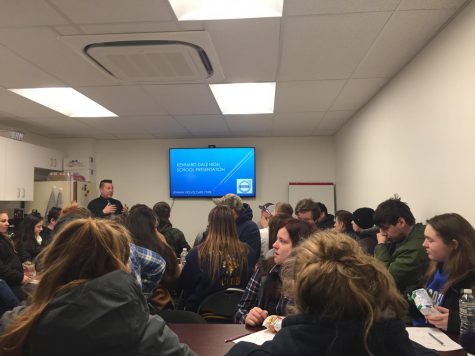
He also informed students about the different sales types, such as leasing and subscription.
If a person wishes to lease, or “rent” a car for a year, they pay a monthly fee but must keep the car under 10 – 15, 000 miles (depending on the dealership) and in good condition.
Subscription is a new form of sales, where you pay a monthly fee but get total car coverage. Staib likened it to an i-Phone purchase. Like most subscriptions, the benefit of this, is you can cancel any time. More information can be found here.
At Volvo, they call it “Care” and it includes everything from insurance, repair, and mileage forgiveness.
“I think this is going to be the new way to buy a car,” Staib stated.
To better inform students, he taught them some common terminology they might hear when buying a car, such as: “Loan-to-value” and “equity”.
Finally, he closed with a discussion about car warranties and where some companies have “hidden fees” such as protection plans.
“I think the car dealership was a little overwhelming with a lot of information. I know that they had other things planned but were unable to do so because of somethings that came up. However, the information was good,” said Updegrove.
After their first stop, both groups of students met at the York Galleria food court to have a 45-minute lunch.
Then, they swapped to attend the other field trip location: Springetts Apartments in York.
At this location, students met in the community building where Manager Tyler Meinl welcomed the students and divided them into two smaller groups. One group visited a Corporate, long stay apartment and the other visited a one-bedroom apartment.
At each apartment, consultants Michele Schultz and Brittney Barnes explained what students should look for in an apartment and provided specific information about Springetts apartments.
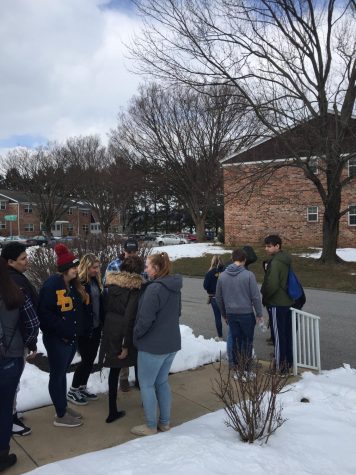
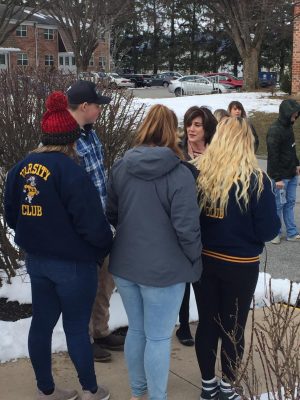
They introduced students to the grounds, which have a pool, a fitness center, a dog park, and as ports complex for volleyball and tennis.
Students inquired about pets, since there was a dog park, and Barnes and Schultz explained that all pets are permitted in Springetts apartments, but there are pet deposits and monthly charges for them. They do limit the size of the dog.
Schultz explained that they can rent apartments by size, but that there are legal requirements that say no more than two people can live in a one-bedroom apartment, four people in a two-bedroom, and so on.
They informed students of the actual square footage in each apartment at Springetts: a one-bedroom has 926 feet; a two-bedroom has 1,173 feet, and a three-bedroom has 1,437 feet.
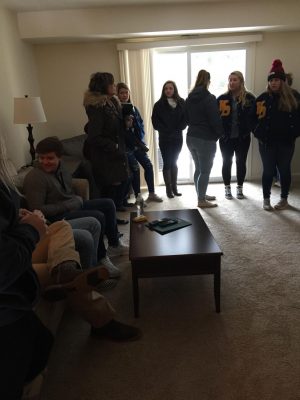
Springetts also has a firewall between apartments and additional materials between the upstairs and downstairs apartments to limit sound to neighbors.
“I liked going to the apartments and learning about the community,” senior Jacob Moser said.

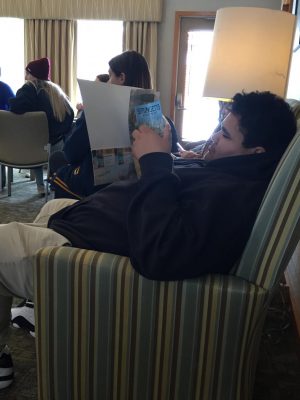
Once students toured the apartment, both groups reconvened in the community building where Meinl and Schultz explained the application process of potential renters. They stressed the importance of good credit, a clean legal record, and that a renter make enough money to afford the apartment with ease.
“I learned about the Fair Housing Act, and how it protects people [who want to rent],” said wrestler Daemon Davis.
Overall, students seemed to appreciate the goal of the trip.
“I thought it was very useful for those who haven’t been through the process or knowing what to do to get a car or an apartment. I thought the apartment one was useful for me, because I haven’t been through that, but I’ve already bought a car,” said senior Stephen Shumar.
Rick Meinl and Updegrove both stated the field trip was made possible thanks to a South Eastern Community Education Foundation (SECEF) grant. “This required submitting a budget and essay explaining how the trip would benefit students and enhance programs at SESD,” said Rick Meinl.
The goal of the SECEF organization is to “support the overall teaching and learning goals embedded in the SESD curriculum” by providing funds for starter projects, above and beyond projects, and other benefit projects.
